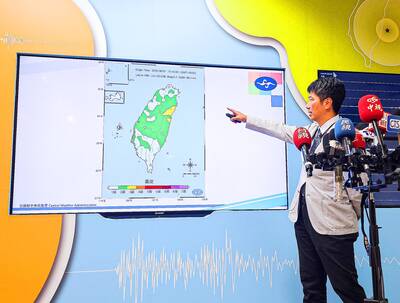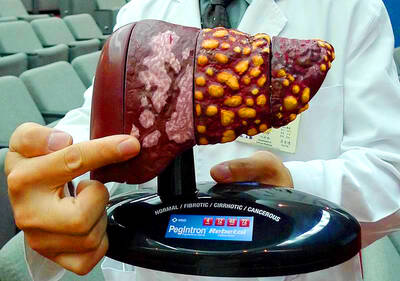Merchants conspiring to pass oilfish for the more expensive cod may soon be unable to do so, as a Barcode of Life Databank (BOLD) capable of identifying fish samples within days is under way and would be completed as early as next year, the Council of Agriculture (COA) said yesterday.
The COA-funded BOLD project is part of the Consortium for the Barcode of Life (CBOL), an international collaboration project devoted to identifying global biological species using DNA barcodes, said project leader and research fellow at the Academia Sinica’s research center for biodiversity, Shao Kwang-tsao (邵廣昭).
“DNA barcoding is a taxonomic technique that uses short but species-specific DNA sequences in the genome for species identification,” Shao said.
The most common section of DNA used is cytochrome c oxidase subunit 1 (CO1), a gene in the mitochondria, because CO1 variation is very small within species but disparate in different species, he said.
Once a species’ CO1 sequence is filed into BOLD, the speedy and economical DNA barcode can analyze fish samples within 3 days for less than NT$1,000.
“For example, when a cargo of fish comes into the country via seaports, we can identify what type of fish they are even with their heads and tails cut off so that consumers can be sure of the type of fish they are purchasing,” he said.
Seaport patrols can similarly use the technique to prevent illegal fish smuggling, he said.
Among the 300-some fish commonly consumed by Taiwanese, 200 fish types have already been successfully identified, Shao said, adding that the databank would be completed by next year.
Though the project was commissioned by the COA, commercial fish identification was merely a “side benefit” of the BOLD project, center research assistant Chen Hsuan-wen (陳宣汶) said.
“Including fish species, CBOL has so far documented 38,762 species globally with 392,594 records in the bank,” he said. “Biodiversity is an invaluable resource we have. For people to know ways to conserve the ecosystem, we must first know what is out there.”
BOLD is a collaboration of international scholars to build a complete global biodiversity databank, aimed at fostering in people a better understanding and appreciation for the vastness of the variety of life on the planet, he said.
For example, he said, the databank can be useful when assessing the biodiversity impact and feasibility of development of a certain area.
“The current environmental impact assessment (EIA) process allows limited time for EIA committees to obtain information on the biodiversity of proposed construction sites,” he said. “If, say, a comprehensive BOLD system was in place, the Suhua Freeway EIA committee would be able to quickly understand the endemic ecosystem, from microorganisms to higher level animals, and make a better informed decision based on the information.”
BOLD further provides continuity in biodiversity taxonomy research, Chen said.
“Many species may not be observed easily, so to pass down valuable information effectively, a globally understandable identification system would be very important, and DNA barcodes fit the bill,” he said.

Aftershocks from a magnitude 6.2 earthquake that struck off Yilan County at 3:45pm yesterday could reach a magnitude of 5 to 5.5, the Central Weather Administration (CWA) said. Seismological Center technical officer Chiu Chun-ta (邱俊達) told a news conference that the epicenter of the temblor was more than 100km from Taiwan. Although predicted to measure between magnitude 5 and 5.5, the aftershocks would reach an intensity of 1 on Taiwan’s 7-tier scale, which gauges the actual effect of an earthquake, he said. The earthquake lasted longer in Taipei because the city is in a basin, he said. The quake’s epicenter was about 128.9km east-southeast

The Taipei Summer Festival is to begin tomorrow at Dadaocheng Wharf (大稻埕), featuring four themed firework shows and five live music performances throughout the month, the Taipei Department of Information and Tourism said today. The festival in the city’s Datong District (大同) is to run until Aug. 30, holding firework displays on Wednesdays and the final Saturday of the event. The first show is scheduled for tomorrow, followed by Aug. 13, 20 and 30. To celebrate the 30th anniversary of Disney Pixar's movie Toy Story, the festival has partnered with Walt Disney Co (Taiwan) to host a special themed area on

BE CAREFUL: The virus rarely causes severe illness or death, but newborns, older people and those with medical conditions are at risk of more severe illness As more than 7,000 cases of chikungunya fever have been reported in China’s Guangdong Province this year, including 2,892 new cases last week, the Centers for Disease Control (CDC) yesterday said it is monitoring the situation and considering raising the travel notice level, which might be announced today. The CDC issued a level 1 travel notice, or “watch,” for Guangdong Province on July 22, citing an outbreak in Foshan, a manufacturing hub in the south of the province, that was reported early last month. Between July 27 and Saturday, the province reported 2,892 new cases of chikungunya, reaching a total of 7,716

STAY VIGILANT: People should reduce the risk of chronic liver inflammation by avoiding excessive alcohol consumption, smoking and eating pickled foods, the physician said A doctor last week urged people to look for five key warning signs of acute liver failure after popular producer-turned-entertainer Shen Yu-lin (沈玉琳) was reportedly admitted to an intensive care unit for fulminant hepatitis. Fulminant hepatitis is the rapid and massive death of liver cells, impairing the organ’s detoxification, metabolic, protein synthesis and bile production functions, which if left untreated has a mortality rate as high as 80 percent, according to the Web site of Advancing Clinical Treatment of Liver Disease, an international organization focused on liver disease prevention and treatment. People with hepatitis B or C are at higher risk of